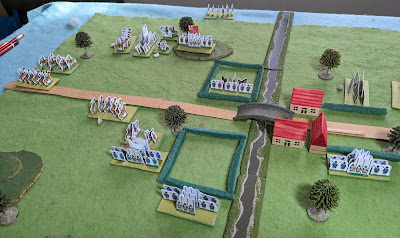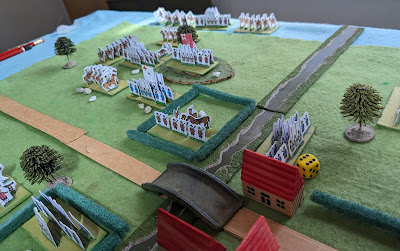'The Archers' is a British institution. Set in the village of Ambridge, this BBC radio 'everyday story of country folk' has been running since 1951, and is now the longest-running drama series in the world. At some point in its history it was established that there was a battle at Ambridge during the English Civil War so, of course, it would be rude not to have a go at refighting it.
To be fair, from what I can find out, there is pretty much no information about the battle aside from the fact that it happened in 1642, so any reconstruction is going to be somewhat conjectural. However Battle Of Bridgeton at Elenderil's 'Small But Perfectly Formed' blog is probably as good as we're going to get for a source, since it's based on notes provided by the BBC to a group from the Sealed Knot who were involved in a episode of the series which featured a reconstruction of the battle. In the comments on the blog Elenderil speculates that the battle may be based on that of Powick Bridge, which was certainly fought in the same area as The Archers is set, but his scenario isn't Powick Bridge.
Elenderil's scenario has the following background:
"The Royalists are preparing for the 1643 campaign season by bringing new recruits from Wales and the Welsh borders into Central England to join the King's main field army. After reaching the West Midlands they find the route blocked by a well fortified garrison at a significant river crossing. Marching downstream to secure crossings away from that garrison they hope to cross at the small village of Bridgeton where an old Roman road crossed the river at fords and a medieval bridge. As they cross a ridge line to the West of the village their Cavalry scouts report a force of the local Parliamentarians approaching from the East. The Parliamentarian force is tasked with denying the crossing to the Royalists and preventing them from moving further East"
Anyway, I took Elenderil's scenario, and fiddled with it a little, firstly in order to scale down the forces and terrain in order to fit it on an 8x8 portable wargame grid and, secondly, to put the village of Ambridge closer to the centre of the action by allowing some deployment on both sides of the River Am. For some reason he sets it in early 1643, although the only map I can find showing the location of the battlefield says 1642.
Here's the terrain setup, looking north. The River Am runs north-south and cannot be crossed except at the bridge. The village of Ambridge lies to the east of the river. The Royalists will approach from the south, looking to secure the road and the river-crossing in order to avoid a large Parliamentarian garrison on the river elsewhere (maybe the nearby town of Borchester). Parliament has sent troops from the garrison to hold the crossing, and they have marched from the east along the road and formed up to the north of the village.
1 x Raw Pike & Shot
8 Initiative Dice, Breakpoint 11
On the whole it was a pretty easy win for the Royalists; they never seemed in much trouble. I ran it through again, and they had a slightly harder time, but still picked up a win in seven turns. I may tweak the forces a little to make their job a touch harder.
Not that Elenderil's scenario has the village on the other side of the river; I moved it to make the main area of the board less cluttered. There are two river crossings as well. I simplified that too. Looking at semi-official maps of Ambridge, it actually appears that the river runs east-west, and that the main part of the village lies to the north:


















There is actually a real Ambridge. It is a hamlet in Staffordshire, and yes, it is next a bridge over a river. (I drove through it while on a business trip some years ago).
ReplyDeleteAfter I published this post, I found this, which speculates that the 1642 battle fought near 'Ambridge' was actually Edgehill:
Deletehttps://www.theatrebubble.com/2015/03/is-this-the-real-location-of-ambridge/
Did the trialled ‘flank attack’ rule (if in more than one frontal zone rule) play any (or a significant…) part, Kaptain?
ReplyDeleteThere were a couple of retreats from flank contacts, yes. It didn't seem to adversely affect the game.
DeleteTo be honest I'm having more issues with the artillery co-location rule at the moment :)
Good to hear the flanking situation seems to have worked…and good luck with the gonnes….
Delete